George Wallace Post arrived in Torrance from York, Nebraska in 1913, one year after the new city was founded by Jared Sidney Torrance.
Torrance had suggested to his old friend Post that he come out to California and help him with the establishment of a bank for the new city.
Post was 65 when he arrived in California after having been a lawyer, tax collector, public official and banker in Nebraska.
Immediately upon his arrival in Torrance, he set about establishing what would become the city’s first bank, setting up the First National Bank of Torrance.
Its first home was in a striking building designed by architect Irving Gill, famed for designing the iconic Pacific Electric bridge over Torrance Boulevard and the railroad depot that later became The Depot restaurant. It was located at El Prado and Border Street.
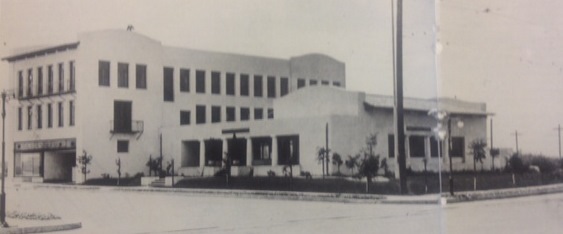
The first home of the First National Bank of Torrance was in this one-story building, foreground, designed by Irving Gill. (Photo: Historic Torrance: A Pictorial History of Torrance, California)
The new bank opened for business on May 2, 1913. Its first board of directors included Post, its president, Jared Sidney Torrance, bank vice president George W. Neill, and the bank’s cashier and Post’s son, James Wallace Post.
Judge Post, as he always was known during his time in Torrance, had a remarkable impact upon the city in its early days, second probably only to Jared SidneyTorrance himself.
His successors would play key roles in the city’s banking industry for the next 79 years.
Judge Post was so respected and revered for his role in keeping the area’s finances stable during World War I that Guadaloupe Avenue in Torrance was renamed Post Avenue in his honor after the war ended.
By then, had moved its headquarters into a brick two-story building at the corner of Sartori and Marcelina avenues downtown.
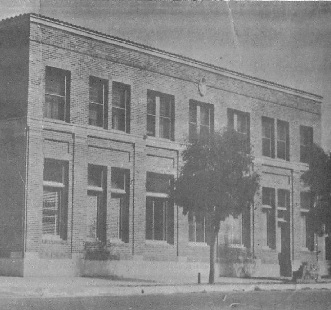
The First National Bank of Torrance moved to this brick building at Sartori and Marcelina avenues in 1921. (File photo)
Post died of pneumonia in Torrance on June 30, 1923, two years after the city’s incorporation.
Judge Post’s son, James Wallace Post, became the bank’s president after his father’s death.
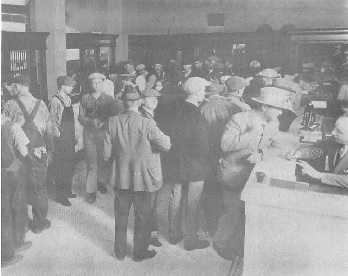
Customers flock to the First National Bank of Torrance in this undated file photo from 1929.
As did many financial institutions during the boom years of the 1920s, The First National Bank of Torrance thrived. A full-page ad in the Torrance Herald from May 1, 1925 trumpeted the bank’s resources as having passed the $1 million mark.
In addition to James Post being a bank president, he apparently also had another income-producing venture on the side. He was fined $500 in August 1925 for possessing a large quantity of “imported and choice brands of liquor,” according to a Los Angeles Times story.
Police suspected Post of distributing the hooch, but only fined him on the possession charge once Post admitted his guilt in court.
After the onset of the Depression, economic turbulence would lay the bank low in the 1930s.
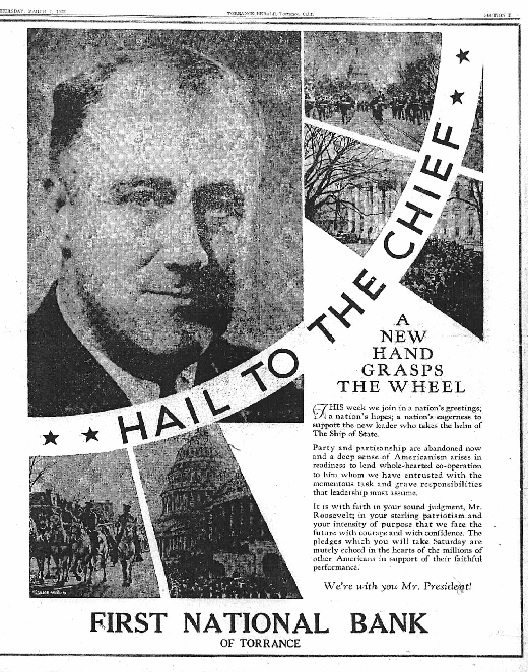
The First National Bank of Torrance took out this full-page ad in the Torrance Herald praising FDR on March 2, 1933, 4 days before the bank holiday. (Credit: Historical Newspapers Archive, Torrance Public Library)
Bank closures and failures as a result of the Depression grew severe in the first couple of months of 1933. President Franklin Delano Roosevelt responded to the panics by declaring a national bank holiday on March 6, 1933, and Congress passed the Emergency Banking Relief Act three days later.
When the nation’s banks reopened one week later, the crisis had been stabilized for most institutions.
Unfortunately, the First National Bank of Torrance as then constituted did not survive the bank holiday.
Despite continual optimistic reports about its pending reopening, the bank remained closed after the bank holiday ended, and for many months after that.
It would be more than a year later until the Reconstruction Finance Corporation would approve the opening of the reorganized bank in a letter dated April 13, 1934.
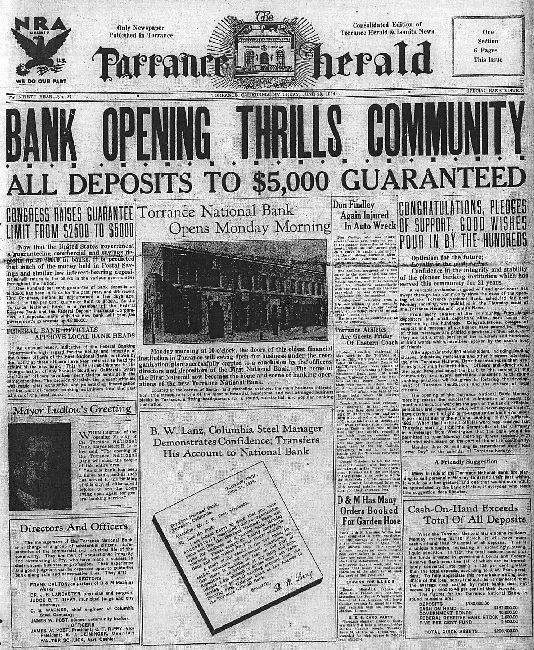
The Torrance Herald front page heralds the upcoming Torrance National Bank opening in its June 23, 1934 edition. (Credit: Historical Newspapers Archive, Torrance Public Library)
Under the leadership of James Post, the successfully reconstituted financial institution reopened on Monday, June 25, 1934, with a new name: The Torrance National Bank.
It had weathered the storms of the Depression, and would prosper for the next 20 years.
In 1954, the Torrance National Bank was acquired by California Bank, which would later become United California Bank. The downtown Torrance bank became a branch location of California Bank on May 24, 1954, and James Post was named a California Bank vice president.
Post died a few months later on Oct. 5, 1954, after a brief illness.
His son, George W. Post, grandson and namesake of the bank’s founder, carried on the family tradition.
He had worked at the Torrance National Bank since 1949, and became manager of the Torrance United California Bank branch in 1959. He was named a vice president at UCB in 1962.
In 1973, George Post decided to leave UCB and begin another venture, a new version of the Torrance National Bank. It was the first independent and locally owned new bank to open in the South Bay since 1934.
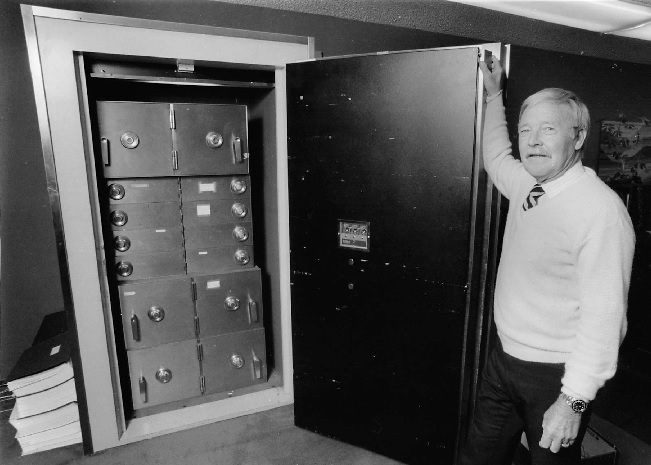
George W. Post, grandson of the First National Bank of Torrance’s founder, in front of the vault at his Torrance National Bank in November 1988. (Daily Breeze file photo)
The bank, at 2860 Sepulveda Boulevard, between Hawthorne and Crenshaw boulevards, opened its doors on Saturday, Oct. 20, 1973. During its seventeen-year run, Torrance National became one of the top local banks in Southern California.
It was acquired by Home Bank in May 1990.
George W. Post retired in 1992, ending the Post family’s 79-year run as local banking figures.
In 2004, he was given the Torrance Award by the city for his years of both banking service and civic involvement.
Sources:
Daily Breeze files.
Historic Torrance: A Pictorial History of Torrance, California, by Dennis F. Shanahan and Charles Elliott, Jr., Legends Press, 1984.
History of Torrance: A Teacher’s Resource Guide, Torrance Unified School District, 1964.
Los Angeles Times files.
Torrance Herald files.
